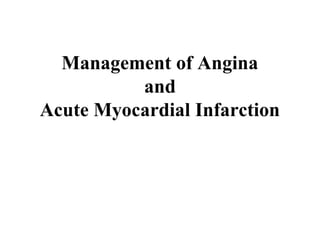
M of angina & ami
- 1. Management of Angina and Acute Myocardial Infarction
- 3. I. Stable angina pectoris Ischaemia due to fixed athromatous stenosis
- 4. II. Unstable angina Dynamic obstruction due to plaque rupture and superimposed thrombosis
- 5. III. Acute Myocardial Infarction Myocardial necrosis due to acute occlusion of coronary artery
- 6. Acute Coronary Syndrome Unstable Angina & AMI
- 7. Factors infulencing myocardial oxygen supply and demand OXYGEN DEMAND Cardiac work- Heart rate, blood pressure Myocardial contractility, LV hypertrophy
- 8. OXYGEN SUPPLY Coronary blood flow Duration of diastole Coronary perfusion pressure Coronary vasomotor tone Oxygenation- haemoglobin oxygen saturation
- 9. Activities precipitating angina Physical exertion Cold exposure heavy meals Intense emotion Lying flat Vivid dreams
- 10. Risk stratification in stable angina HIGH RISK Post infarction angina Poor effort tolerance Ischaemia at low work load Lt main or three vessel disease Poor LV function
- 11. Low risk Predictable exertional angina Good effort tolerance Ischaemia only at high workload Single or minor two vessel disease Good LV function
- 12. Management of Angina Careful assessment of the likely extent and severity of arterial disease Identification and control of significant risk factors Use of measure to control symptoms Identification of high risk patients and application of treatment to improve life expectancy
- 13. Advice to patient with stable angina .Do not smoke .Ideal body weight regular exercise .Avoid severe , unaccustomed exercise, vigorous exercise after heavy meal or in very cold weather .Sublingual nitrate before exertion that may induce angina
- 14. II. MEDICAL TREATMENT A. Symptomatic ( prevent or relieve angina Nitrates- Sublingual / buccal GTN Transdermal GTN Oral long acting ntrates (isosorbide mono/dinitrates) -Beta blockers- Atenolol 50-100 mg/d Metoprolol 25-50 mg/d
- 15. -Ca channel blocker ( when beta blocker is contra-indicated or in case of coronary spasm) Nifedipine 5- 20 mg 8 hourly Nicardipine 20-40 mg 8 hourly Amlodipine 2.5-10 mg od Diltiazem 60-120 mg 8 hourly Verapamil 40-80 mg 8 hourly
- 16. Potassium channel activator Nicorandil sodium 10-30 mg 12 hourly
- 17. B. Prognostic treatment ( To improve long term prognosis and prevent coronary event ) -Asprin – 75-150 mg/d -Other antiplatelet – Clopidogrel( if patient can not tolerate asprin) 75 mg daily -Lipid lowering agents- Statins, Fibrates
- 18. III. SURGICAL ( INVASIVE ) TREATMENT A. Percutaneous Coronary Intervention -Balloon angioplasty -Implantation of coronary stent
- 19. B. Coronary Artery Bypass Graft ( CABG ) Antiplatelet ( Asprin and Clopidogrel ) and aggressive lipid lowering therapy shown to slow progression of disease in native coronary vessel and bypass graft
- 20. Comparism of PCI and CABG PCI CABG Death 0.5% 1.5% MI 2% 10% Hospital stay 12-36 hour 5-8days Return to work 2-5 days 6-12weeks Recurrent angina 30% at 6 month 10% at 1 year Recurrent revascularisation 20% at 2 yr 2% at 2 yr Nerological complication Rare common Other complications Emergency CABG Diffuse myocardial Vascular damage damage Infection Wound pain
- 21. Management of Acute Myocardial Infarction
- 22. DIAGNOSIS OF AMI At least two of the followings - History of ischaemic type of chest pain - Evolving ECG changes - Rise and fall of cardiac enzymes
- 23. ST Elevation Q wave
- 24. CARDIAC ENZYMES Enzymes Peak Persist Troponin I 2-4 hours 7 days CKMB within 24 hours 48 hours SGOT ( AST ) 48 hours 72 hours LDH 72 hours 10 days
- 25. Treatment of Acute Myocardial Infarction
- 26. Acute condition Keep in coronary care unit ( CCU ) provide facilities for defibrillation High flow oxygen IV access and ECG monitor for arrhythmias
- 27. Pain relief- IV morphine 10mg or diamorphine 5 mg with metoclopramide or cyclizine Asprin -300 mg chewed
- 28. REPERFUSION IV thrombolysis with Streptokinase 1.5 million units over 1 hour (within 12 hour after onset of chest pain) Other thrombolytic agents- r TPA
- 29. Urgent PTCA As primary treatment Failed thrombolysis Contraindication to thrombolysis Re infarction
- 30. Other treatments -IV atenolol – improve survival prevent myocardial rupture IV nitrate infusion- for persistent pain Anticoagulants( SC heparin) in addition to oral asprin may prevent reinfarction after thrombolysis and prevent DVT and pulmonary embolism
- 31. SUBSEQUENT MANAGEMENT ( SECONDARY PREVENTION ) Oral beta blocker ( atenolol ) if LV function is good ACEI if LV function is poor Asprin 75-100 mg/d ay
- 32. Lipid lowering therapy Modification of risk factor – Smoking, exercise, diet PTAC or CABG
- 33. ACUTE COMPLICATIONS OF AMI Cardiac arrest Cardiac arrhythmias (especially ventricular arrhythmia ) Cardiac conduction disturbance ( heart block ) Cardiac failure- extensive myocardial infarction Cardiogenic shock Pericarditis
- 34. LATE COMPLICATIONS OF AMI Recurrent angina or infarction Thromboembolism Mitral regurgitation – ruptured cordae tendinae/ papillary muscle dysfunction Ventricular free wall rupture- haemopericardium Ventricular aneurysm Acute ventricular septal defect
- 35. Post-myocardial infarction syndrome (Dressler'ssyndrome ) Immunological reaction- fever,arthralgia,pericarditis, pericardial effusion Recurrent arrhythmias Shoulder hand syndrome Psychological- depression
- 36. POOR PROGNOSTIC FACTORS Old age Large infarct Poor LV function Residual myocardial ischaemia Ventricular arrhythmias
